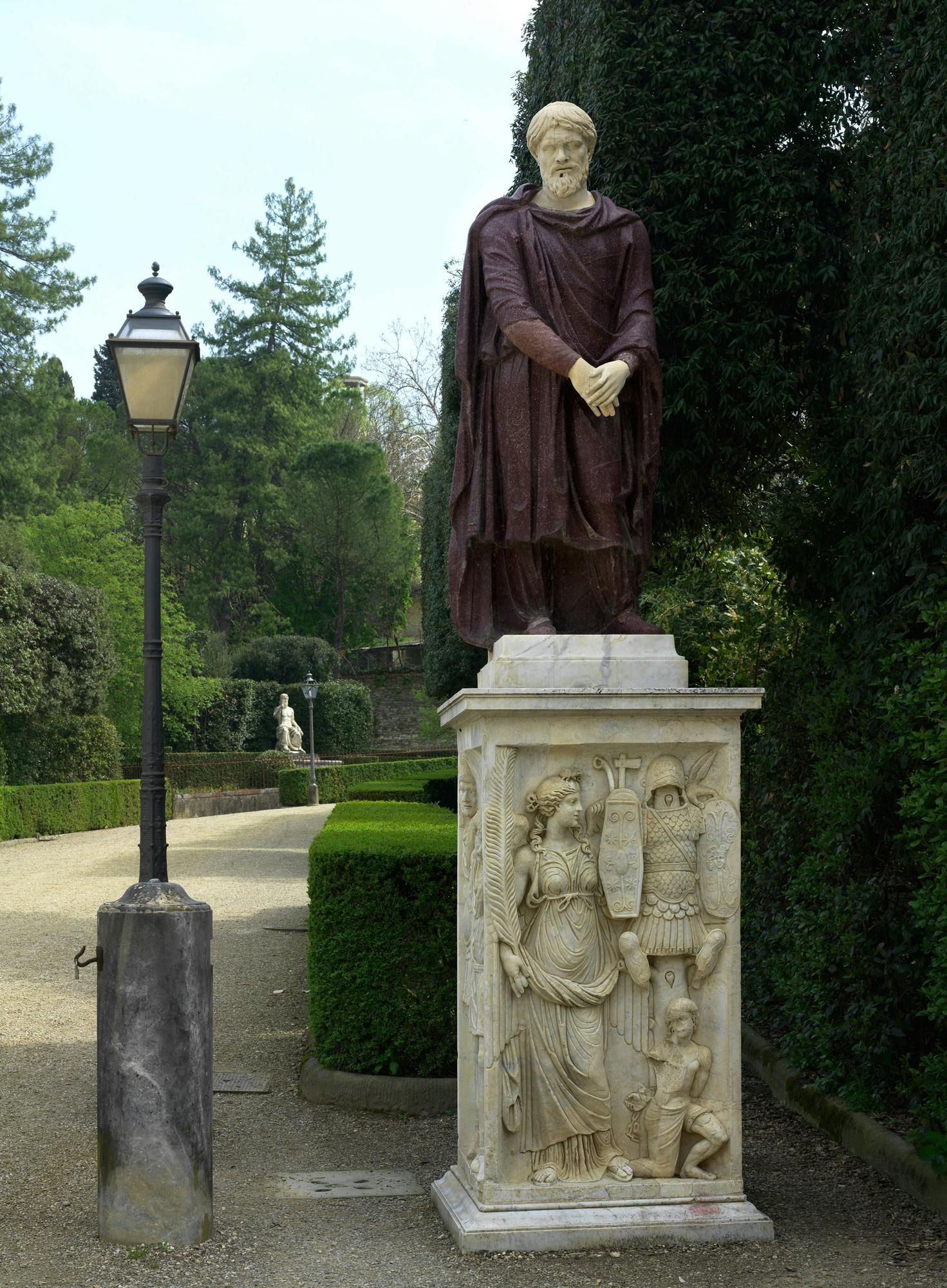Statue of a barbarian prisoner (Dace capillatus o comatus)
Roman art
The sculpture, which is bigger than human size, depicts a barbarian dressed in a tunic, bracae and with a cloak buckled over his right shoulder. The expression of pain in his face and the position of his hands clasped on the lap refer to the iconography of the defeated and captured barbarian that evolved during the 2nd century A.D. The type of dress, in particular, allows to identify the man as a Dace comatus, i.e. a member of that social group of freemen that formed most of the army. The head, made in white marble, was reapplied and is probably pertinent. The statue was first restored in the 16th century by Lorenzetto and underwent other integrations carried out by F. Carradori between 1787 and 1793 (Cecchi-Gasparri 2009 p. 196).
The Florentine statue was reported to be among the collection of the Roman cardinal Andrea della Valle since the first half of the 16th century. As a matter of fact, it is depicted in a drawing by M. van Heemskerck pertaining to the courtyard of Palazzo Valle-Capranica (Michaelis 1891 pp. 229-230), and it is also mentioned in the descriptions of some antiquarians of the time such as U. Aldovrandi (1556 pp. 217, 220) and J. J. Boissard (1587-1602 pp. 41-42). Purchased by Ferdinando de' Medici in the 1570s, the statue was moved to the villa on the Pincian Hill, where it used to decorate the rear façade overlooking the garden (Cecchi-Gasparri 2009 p. 196). It was then transferred to Florence between the 1770s and 1780s, together with most of the statues from the Roman villa. In 1809, together with the second Dacian figure in porphyry, the statue was moved to adorn the main entrance to the Boboli Gardens, where it still stands. Together with the friezes with chained barbarians of the Arcus Novus (Richardson 1992 p. 27) placed at their bases, they formed a monument to celebrate the military glories of the French emperor (Capecchi 2008 p. 142-144,157).
The statue belongs to a large series of sculptures made in different sizes and marbles that depicted Dacians wearing the pileus or with long flowing hair. In all probability, this cycle of sculptures, whose iconography is rather homogeneous, was intended for the decoration of the grandiose complex off the Trajan's forum, which was inaugurated in 112 A.D. The use of different stones for the realisation of these sculptures, such as pavonazzetto, red porphyry, serpentine and white marble, ensured a chromatic variety that reaffirmed the royalty of the space in which they were placed (Capecchi 2008 pp. 155-157; Ungaro 2017 pp. 146-147). The existence of several series with similar dimensions (Capecchi 2008 p. 157) suggests different arrangements within the whole complex, although it is highly probable that sculptures made of highly valuable marble, such as red porphyry, were guaranteed positions of higher visibility.
P. Zanker, Das Trajansforum in Rom, Archäologischer Anzeiger, 1970, p. 510; L. De Lachenal, Fortuna dei prigionieri Daci a Roma, Xenia Quaderni, 7, 1987; L. De Lachenal, I prigionieri Daci della Collezione Medici-Della Valle: nuove considerazioni archeologiche antiquarie sulle loro vicende tra Roma e Firenze, in Boboli ’90, Atti del convegno internazionale, Firenze 1991, pp. 609-621; A. M. Riccomini, Il viaggio in Italia di Pietro De Lama. La formazione di un archeologo di età neoclassica, Pisa 2003; G. Capecchi – M. G. Marzi – V. Saladino, I Granduchi di Toscana e l’antico. Acquisti, restauri, allestimenti, Biblioteca dell'Archivum romanicum, n. 352, Firenze 2008, pp. 131-179; A. Cecchi, C. Gasparri, La Villa Médicis, Le collezioni del cardinale Ferdinando, IV, I dipinti e le sculture, Roma 2009, pp. 196-197, n. 227.1; L. Velcescu, Les Daces dans la sculpture romaine. Étude d’iconographie antique, Saint Estéve 2010; M. Bormand – B. Paolozzi Strozzi (a cura di), Le printemps de la Renaissance. La sculpture et les art à Florence 1400-1460, Catalogo della mostra, Paris, Musée du Louvre (26 settembre 2013-6 gennaio 2014), Paris 2013; L. Ungaro, Il potere ritratto nel Foro di Traiano, in Traiano 2017, pp. 146-150
Dacian prisoner
Roman Art
